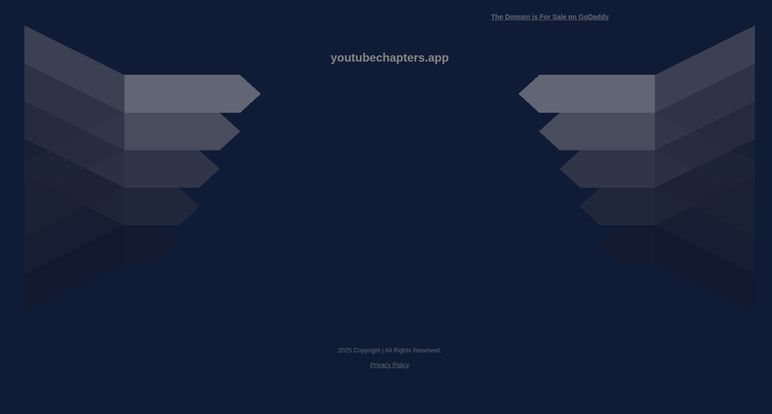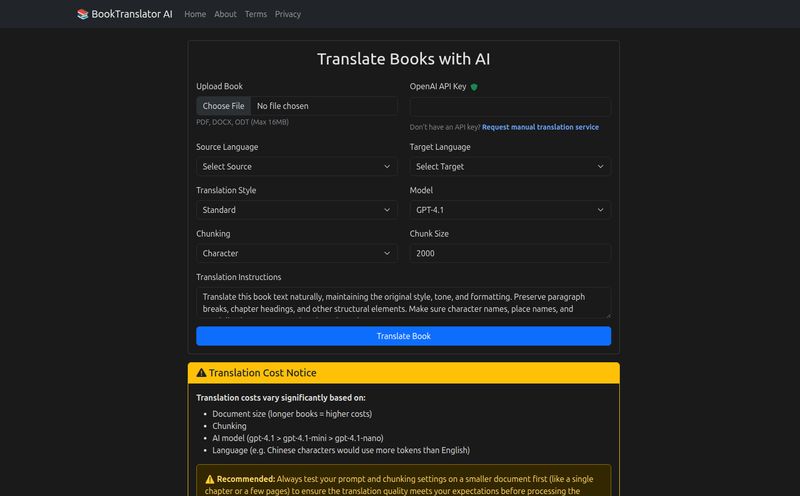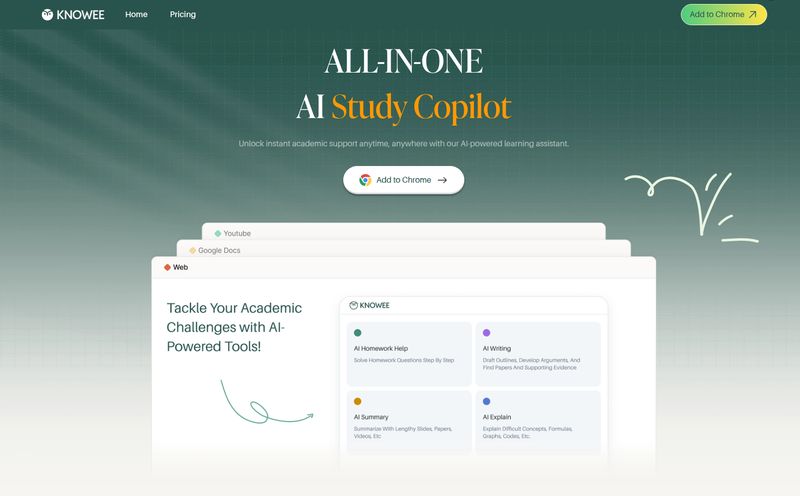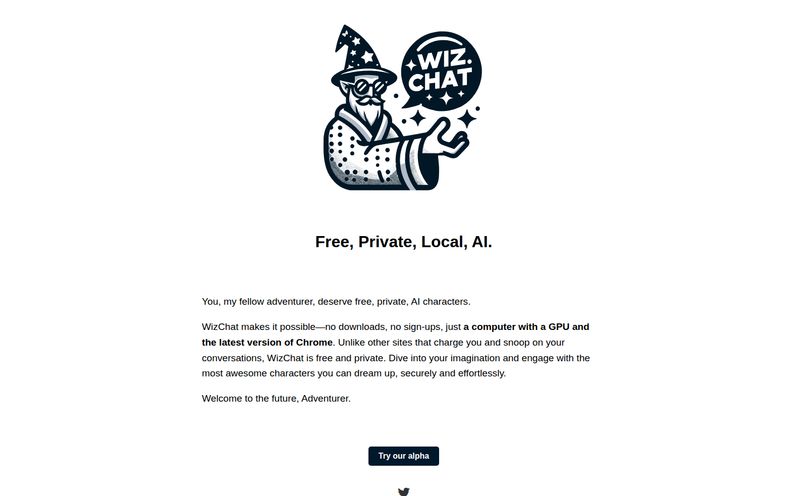That Feeling When You Find the Perfect Tool… And Then It’s Gone
We’ve all been there. Staring at a 58-minute YouTube video titled something like “Complete Guide to Advanced SEO Audits” when all you need is that one tiny nugget of information about canonical tags. You start scrubbing through the timeline, watching the little red bar jump, hoping to land on the magic moment. It's a digital treasure hunt where the prize is… saving 45 minutes of your life.
So, when a tool pops up that promises to slay this dragon for you, it feels like a revelation. I remember stumbling upon a little app, a real gem, called YouTubeChapters.app. The premise was so simple, so beautiful: paste a YouTube link, and an AI—powered by the now-famous ChatGPT—would spit out a concise summary, complete with clickable chapters to hop directly to the good stuff. It was the dream, right? A way to skim the firehose of YouTube content and drink only what you need.
It promised to be the ultimate time-saver for students, researchers, and us content folks who have to consume mountains of information daily. And for a glorious moment, it worked.
What Exactly Was YouTubeChapters.app Supposed to Be?
Let's pour one out for what could have been. The idea behind YouTubeChapters.app was brilliant in its simplicity. It wasn't just another video downloader or a clunky transcription service. It was designed to be an intelligent assistant.
You’d feed it a long, meandering video, and its AI brain, specifically leveraging ChatGPT, would get to work. It would first transcribe the audio and then, like a very efficient intern, read through the whole thing and summarize the key points. The output wasn't just a wall of text; it was structured with timestamps. You could read a sentence in the summary, think, “Ah, that’s what I need,” and click to be taken to that exact moment in the video. It was a thing of beauty.
It was the kind of tool that makes you feel like you’re living in the future. No more wasted time, just pure, distilled knowledge. And the best part? It was free. Or so it seemed.

Visit YouTubeChapters.app
The Brutal Reality of “Free” AI
So, I went to check on my new favorite productivity hack the other day, ready to summarize a lengthy conference talk. And I was greeted with a digital tombstone. A simple, stark message on a dark blue background: “The Domain is For Sale on GoDaddy.”
Oof. I've been in the SEO and digital marketing game long enough to know what that means. It’s the sign of a great idea that ran into the brick wall of reality. And it’s a story I’ve seen play out time and time again in the tech world.
Why did it disappear? While I don’t have the team’s internal memos, I can make a pretty educated guess. The very thing that made it great—the powerful AI—is also incredibly expensive to run. The 'cons' listed on its own info page even hinted at it: “Transcription costs may require user support to keep the service free.”
The Hidden API Bill
Running these services isn't magic. It involves making calls to powerful models like those from OpenAI. Every video summarized, every sentence transcribed, costs money. It’s a literal pay-per-word transaction happening behind the scenes. When a tool is offered for free, the developer is footing that bill. And as a tool gets popular, that bill can skyrocket from a few dollars to thousands, very, very quickly. It's a classic startup death spiral: success leads to higher costs, which, without a solid business model, leads to shutdown.
The AI Isn’t Perfect Either
Let’s also be honest about the tech itself. AI summaries are amazing, but they’re not infallible. An AI can miss sarcasm, irony, or the subtle context of a visual gag. I’ve seen AI summarizers completely misinterpret the tone of a speaker or latch onto a repeated phrase and think it’s the main point, when its just a verbal tic.
“I once used a similar tool to summarize a comedy roast. The AI’s summary was a dry, literal interpretation that made it sound like a very serious and insulting corporate meeting. The nuance was completely lost. It was hilarious, but not for the reasons the original video was.”
This isn't a knock on the technology—it's getting better every day. But it highlights the challenge. You're paying a premium for a service that is, by its nature, sometimes going to be a little bit… off. That can be a tough sell.
So Where Do We Go From Here? Alternatives That Are Still Standing
The demise of YouTubeChapters.app is a bummer, but it doesn’t mean the dream is dead. It just means we need to be more realistic. The good tools in this space usually cost a little money, and that's okay! It means they have a sustainable business model and are more likely to stick around. If you’re still hunting for a great YouTube summarizer, here are a few that are currently alive and kicking:
- Eightify: This is a popular browser extension that does a very similar job. It generates AI-powered summaries with timestamps. It operates on a freemium model, giving you a few free summaries before asking for a subscription.
- Glarity: Another browser extension, Glarity summarizes not just YouTube videos but also Google search results and other web pages. It’s a versatile tool for general research.
- Glasp: While also a social web highlighter, Glasp has a neat YouTube summary feature. It's geared more towards learning and note-taking, but it gets the job done.
The lesson here is that sustainability matters. A free tool that disappears is ultimately less useful than a paid one that you can rely on long-term.
Frequently Asked Questions About AI Video Summarizers
Are AI-generated YouTube summaries accurate?
They are getting better! For straightforward informational videos, tutorials, and lectures, they are generally quite accurate at pulling out key topics and points. However, they can struggle with content that relies heavily on humor, sarcasm, visual cues, or complex narratives. Always use them as a guide, not as a perfect replacement for watching the video.
Why aren't all of these YouTube summary tools free?
Because the AI technology that powers them is not free for developers to use. Every time a video is summarized, the tool's creator has to pay for the computation and the API call to a service like OpenAI. A subscription or a one-time fee helps cover these operational costs and allows the tool to have a sustainable future.
Can't I just ask ChatGPT to summarize a YouTube video for me?
You can, but it requires an extra step. ChatGPT can't directly 'watch' videos. You first need to get a transcript of the video (many free online tools do this) and then paste that transcript into ChatGPT with a prompt like, "Please summarize this video transcript and provide key takeaways." Tools like YouTubeChapters.app and its alternatives simply automate this two-step process for you.
What's the biggest benefit of using a YouTube summarizer?
The single biggest benefit is time efficiency. It allows you to quickly assess whether a long video contains the information you need, saving you from watching irrelevant content. It's a powerful tool for research and learning, helping you consume and process more information in less time.
Is it legal and ethical to summarize someone's video?
Generally, yes. Summarizing is a form of 'fair use' similar to writing a review or a report. The tools are analyzing publicly available content. It becomes ethically murky if you try to pass off the summary as your own original content analysis, but for personal use and research, it's widely considered acceptable.
A Toast to the Great Ideas
The story of YouTubeChapters.app isn't really a failure. It's a testament to a brilliant idea and a signpost for where technology is headed. It reminds us that behind every 'simple' and 'free' tool, there's often a complex and costly infrastructure. We're in the wild west of AI implementation, and there will be casualties along the way.
So, RIP YouTubeChapters.app. You were a great idea. Thanks for trying to save us all some time. Now, if you'll excuse me, I have a 72-minute video about Google's latest algorithm update to not watch.



